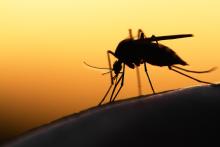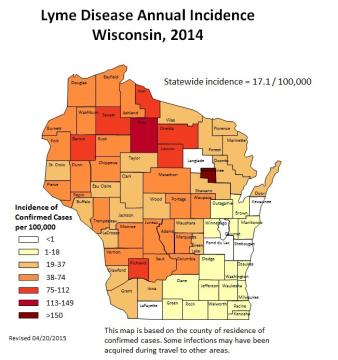Climate and Health: Climate and Infectious Disease
What is the connection between climate and infectious disease?
Wisconsin is generally becoming warmer and wetter. Changes in the climate may lead to more flooding and precipitation, temperature extremes (very hot and very cold days), drought, and more carriers of disease (such as mosquitoes and ticks). These trends could allow for an increase in diseases spread by mosquitoes and ticks. Learn more about simple ways to protect yourself from mosquitoes and ticks on the Enjoy the Outdoors - Bug-free! page.
Diseases spread by mosquitoes
In Wisconsin, we're most concerned about:- West Nile virus (WNV)
- La Crosse/California encephalitis (LAC/CA)
- Jamestown Canyon virus (JCV)
- St. Louis encephalitis (SLE)
- Eastern equine encephalitis (EEE)
Mosquito populations may increase throughout Wisconsin as annual average temperatures go up. Wet or dry weather may allow certain mosquito species to thrive.
In areas with mosquitoes that can spread WNV, warmer winters with fewer hard freezes can lead to more cases of WNV, because fewer mosquitoes die during the winter, which lengthens how long WNV can spread.
Flooding can lead to standing water. Because stagnant water is a perfect home for mosquito breeding, this environment can lead to more mosquitoes and more disease.
In addition, warmer and wetter conditions could lead to new mosquito species in Wisconsin. These mosquitoes can spread new viruses, including the Jamestown Canyon virus, Chikungunya, and Dengue Fever. The Jamestown Canyon virus has been isolated from 22 different mosquito species, including the Anopheles sp. recently detected in water samples collected from Milwaukee urban ponds.
Learn more about diseases spread by mosquitoes.
Diseases spread by ticks
The number of ticks and where they live in Wisconsin may also be changing in response to changing weather and climate. The blacklegged tick (commonly known as deer tick) is the main vector (species that can transmit a disease agent) for the two most common tickborne diseases in Wisconsin: Lyme disease and anaplasmosis. Other tickborne diseases in Wisconsin include ehrlichiosis, Powassan virus, and Babesiosis.
Deer ticks are abundant in northwestern Wisconsin, and over time, we have sen that deer tick populations are spreading into the state's northeastern and southern regions.
Since 2008, there has been an increase in reported cases of Ehrlichiosis in the Eau Claire region of Wisconsin. A new Ehrlichia species (Ehrlichia muris-like) was discovered in Wisconsin and Minnesota in 2009 and has been linked to these cases.
Another emerging tick is the Amblyomma americanum, commonly known as the lone star tick. Recent tick surveillance has reported a few lone star ticks found in southeastern Wisconsin. However, warmer annual temperatures, especially during the winter months, may allow the lone star tick to move into central and northern Wisconsin, bringing with it an increasing risk for Ehrlichiosis (exit DHS), a bacterial illness that can cause fatigue, fever, and headache.
Tick surveillance and tracking projects are ongoing in the northwestern corner and south central parts of Wisconsin in collaboration with the U.W. Department of Entomology, DHS Bureau of Communicable Diseases (BCD), and Eau Claire City-County Health Department, to assess disease prevalence, varying tick phenology, and habitat changes.
To learn more about diseases spread by ticks, check out these resources:
- Tick surveillance brief, P-01295 (PDF)
- Tickborne Disease Risk in Wisconsin fact sheet, P-01751 (PDF)
- Lyme Disease Risk in Wisconsin fact sheet, P-01752 (PDF)
- Visit our Illnesses Spread by Ticks page.
In addition, you can check out our two videos on Lyme disease:
Tips for preventing Lyme Disease
This video is intended for a general audience (especially hikers, campers, and hunters).
Lyme Disease data and resources for health departments
This video is intended for health departments and their partners.



